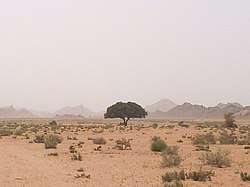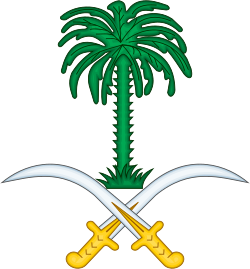Ha'il Region
The Ha'il Province (Arabic: مِنْطَقَة حَائِل Minṭaqat Ḥāʾil), also known as the Ha'il Region, is one of the 13 a provinces of the Kingdom of Saudi Arabia. It is the eighth-largest province by area at 103,887 km² and the ninth-largest by population, with the population in 2017 being 699,774. The province accounts for roughly 2% of the population of the country and is named for its largest city, Ha'il. Other populous cities in the province include al-Ghazalah, Shinan and Baq'aa. The region is famous for the twin mountains of 'Aja and Salma, and for being the homeland of historic symbol of curiosity and generosity, Hatim al-Ta`i.
Haʾil Region مِنْطَقَة حَائِل (in Arabic) | |
|---|---|
Emirate, Province | |
| Ha'il Province | |
 Hilly, desert landscape near the Shammar Mountains | |
 Coat of arms | |
 Map of Saudi Arabia with Ha'il highlighted | |
| Capital | Ha'il |
| Boroughs | 9 |
| Government | |
| • Governor | Abdulaziz bin Saad Al Saud |
| Area | |
| • Total | 103,887 km2 (40,111 sq mi) |
| Population (2017) | |
| • Total | 699,774 |
| • Density | 6.7/km2 (17/sq mi) |
The area is known to have been inhabited since at least since the Paleolithic period, with several archaeological sites dating back to 10000 BC to 7500 BC. Several sites with archaeological rock art and other artifacts have been found in the province.
The province is divided into 8 governorates, and more than two-thirds of the population of the city lives in the capital city of Ha'il. The incumbent Provincial Governor is 'Abdulaziz ibn Sa'ad al-Sa'ud.
History
Prehistory
Archaeological evidence indicates the continuation of human settlement in the Ha'il Province since prehistoric times. The sites dating to the Middle Paleolithic age discovered in and around Ha'il attest that the soil in the area could have held enough water to enable plant life during the period from 75000 BC to 5000 BC.
Neolithic sites are clearly scattered across the northern Arabian Peninsula. Several Neolithic artifacts found in the province date back to the period from 10000 BC to 7500 BC. The artifacts discovered in Hail can be distinguished from others found in Saudi Arabia by the abundance of rock drawings that vary between human and animal figures. The Neolithic period in Ha'il is distinguished by its different environments and diversity, as can be seen in the sandy banks of the valleys, the dune slopes and ancient lake deposits, including those discovered in Jubbah, northwest of Ha'il. Stone tools in separate areas of Ha'il also indicate that the people living in the area lived a life of hunting-gathering, rather than in permanent settlements.
Cultural evidence from the Copper Age (approximately 5500 BC) is most widespread within the Ha'il Province, and among the artifacts found in the area from this age are stone tools with flat sides in the form of scrapers, drills and cleavers. In addition to the discovery of a group of stone formations and circles that characterize the Copper Age, these stone installations indicate that life in this era was more settled than the life of hunting-gathering, which is a striking characteristic of a Neolithic society. Among the signs that prove these settlements are the presence of flint tools, vessels made of rough, unpolished clay and a group of rock inscriptions that together confirm the existence of human activity in the region in prehistoric times.
A striking discovery in the province was that there are more archaeological sites dating back to the Paleolithic period than to the Neolithic. One reason given for this is that the climatic changes from a cold and humid climate in the Paleolithic period to the heat and drought of the Neolithic period and the resulting gradual change in vegetation cover from greenery to desertification led to mass migration to more habitable areas in the Fertile Crescent.
Archaeologists have deduced that the availability of its water, the fertility of the soil, the abundance and distribution of pastures in different directions, and the moderate climate of the region, combined, made it a lot more hospitable than the surrounding Arabian Desert.
Environment

This region hosts the Shammar Mountains' range, further divided into the Aja and Salma subranges.[1][2] There is also a protected area named after Jabal Aja.[3]
History and governance
In 1921, King Abdulaziz captured Ha'il.[4] The province was completely controlled by Al Sauds in 1922.[5]
The region's former governor is Prince Saud bin Abdul Muhsin who was in the post until 2017.[6] Muqrin bin Abdulaziz was the former governor of Ha'il Province from 1980 to 1999.
Population
| Year | Pop. | ±% p.a. |
|---|---|---|
| 1992 | 411,284 | — |
| 2004 | 526,882 | +2.09% |
| 2010 | 605,930 | +2.36% |
| 2018 | 716,021 | +2.11% |
| source:[7] | ||
Rock art
Ha'il Region is the home of the Rock Art site which was inscribed on the UNESCO List of World Heritage Sites in two components: Jabel Umm Sinman at Jubbah and the Jabal al-Manjor and Raat at Shuwaymis.[8]
Governorates
- Ha'il
- Baqa'a
- Al-Ghazalah
- Ash-Shnan
- Sumaira'a
- Mawqaq
- Ash-Shamli
- Al-Sulaimi
- Al-Hayet
Governors
- Muqrin bin Abdulaziz (1980 - 1999)
- Prince Saud bin Abdul Muhsin (1999 - 23 April 2017)
- Abdulaziz ibn Saad ibn Abdul-Aziz Al Saud (23 April 2017 - present)
References
- Cavendish, Marshall (2007). World and Its Peoples. 1. Cavendish Square Publishing. p. 11. ISBN 978-0-7614-7571-2.
- المجاري المائية]، هيئة المساحة الجيوليوجية السعودية - حقائق وأرقام، ص: 65. (PDF) (in Arabic), Saudi Geological Survey, 2012, archived from the original (PDF) on 2013-06-26
- Llewellyn, O. A.; Hall, M.; Miller, A. G.; Al-Abbasi, T. M.; Al-Wetaid, A. H.; Al-Harbi, R. J.; Al-Shammari, K. F. (2011). "Important Plant Areas in the Arabian Peninsula: 4. Jabal Aja'". Edinburgh Journal of Botany. 68 (2): 199–224. doi:10.1017/S0960428611000059.
- Balka, Charles E. (December 2008). "The fate of Saudi Arabia: Regime evolution in the Saudi monarchy". NPS. Retrieved 23 April 2012.
- Al Kahtani, Mohammad Zaid (December 2004). "The Foreign Policy of King Abdulaziz" (PDF). University of Leeds. Retrieved 21 July 2013.
- "Map of Provinces". Royal Embassy of Saudi Arabia, Washington, DC. Retrieved 8 May 2011.
- Saudi Arabia: Regions and Cities
- Centre, UNESCO World Heritage. "Rock Art in the Hail Region of Saudi Arabia". UNESCO World Heritage Centre. Retrieved 2019-02-05.
External links
- A travel through the province of Hail, Splendid Arabia: A travel site with photos and routes
